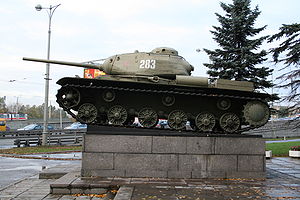KV-series
| KV-1 | |
|---|---|

KV-1 on display in Kirovsk.
|
|
| Type | Heavy tank |
| Place of origin | Soviet Union |
| Service history | |
| In service | 1939–45 |
| Used by | Finland (Captured) , Nazi Germany (Captured), Poland , Soviet Union |
| Wars | Winter War, World War II |
| Production history | |
| Designer | Zh. Kotin, TsKB-2 |
| Designed | 1938–39 |
| Manufacturer | Kirov Factory, ChTZ |
| Produced | 1939–43 |
| No. built | 5,219 |
| Variants | KV-2, KV-8 flamethrower, KV-1S, KV-85, KV-122 |
| Specifications (KV-1 Model 1941) | |
| Weight | 45 tonnes |
| Length | 6.75 m (22 ft 2 in) |
| Width | 3.32 m (10 ft 11 in) |
| Height | 2.71 m (8 ft 11 in) |
| Crew | 5 |
|
|
|
| Armour |
|
|
Main
armament |
76.2 mm M1941 ZiS-5 gun |
|
Secondary
armament |
3× or 4× DT machine guns |
| Engine |
Model V-2 V12 Diesel engine 600 hp (450 kW) |
| Power/weight | 13 hp/tonne |
| Suspension | Torsion bar |
|
Operational
range |
335 km |
| Speed | 35 km/h (22 mph) |
| Kliment Voroshilov 2 | |
|---|---|

KV-2 in Moscow museum with KV-1 in background
|
|
| Type | Heavy tank/assault gun |
| Place of origin | Soviet Union |
| Service history | |
| In service | 1939–45 |
| Used by | Soviet Union |
| Wars | World War II |
| Production history | |
| Designer | Zh. Kotin, TsKB-2 |
| Designed | 1938–39 |
| Manufacturer | Kirov Factory, ChTZ |
| No. built | 334 |
| Specifications | |
| Weight | 52 tonnes |
| Length | 6.95 m (22 ft 10 in) |
| Width | 3.32 m (10 ft 11 in) |
| Height | 3.25 m (10 ft 8 in) |
| Crew | 6 |
|
|
|
| Elevation | about 37° |
|
|
|
| Armour | 60–110 mm (2.4–4.3 in) |
|
Main
armament |
152 mm M-10T howitzer (20 rounds) |
|
Secondary
armament |
2× DT machine guns (2,079 rounds) |
| Engine | 1 x V2-K-12 cylinder diesel 550 hp |
|
Operational
range |
140 km (87 mi) |
| Speed | 28 km/h (17 mph) |
| KV-85 | |
|---|---|

KV-85
|
|
| Type | Heavy tank |
| Place of origin | Soviet Union |
| Service history | |
| Used by | Soviet Union |
| Production history | |
| Produced | 1943 |
| No. built | 130 |
| Specifications | |
| Weight | 46 tonnes |
| Length | 8.49 m (27 ft 10 in) |
| Width | 3.25 m (10 ft 8 in) |
| Height | 2.87 m (9 ft 5 in) |
| Crew | 4 |
|
|
|
| Armour | 30-160 mm |
|
Main
armament |
85 mm D-5T tank gun |
|
Secondary
armament |
3× 7.62 mm DT machine guns |
| Engine | Mikulin Model V-2 V12 Diesel engine 600 hp |
| Power/weight | 11.8 hp/tonne |
| Suspension | Torsion bar |
|
Operational
range |
250 km |
| Speed | 40 km/h (25 mph) |
The Kliment Voroshilov (KV) tanks were a series of Soviet heavy tanks named after the Soviet defence commissar and politician Kliment Voroshilov and used by the Red Army during World War II. The KV series were known for their heavy armour protection during the early part of the war, especially during the first year of the German invasion of the Soviet Union. In certain situations, even a single KV-1 or KV-2 supported by infantry was capable of halting large German formations. German tanks at that time were rarely used in KV encounters as their armament was too poor to deal with the "Russischer Koloss" - "Russian Colossus".
The KV tanks were practically immune to the 3.7 cm KwK 36 and howitzer-like, short barreled 7.5 cm KwK 37 guns mounted, respectively, on the early Panzer III and Panzer IV tanks fielded by the invading German forces. Until more effective guns were developed by the Germans, the KV-1 was invulnerable to almost any German weapon except the 8.8 cm Flak gun.
Prior to Operation Barbarossa, about 500 of the over 22,000 tanks then in Soviet service were of the KV-1 type. As the war progressed, it became evident that there was little sense in producing the expensive KV tanks, as the T-34 medium tank performed better (or at least equally well) in all practical respects. In fact the only advantage it had over the T-34/76 was its larger and roomier three-man turret. Later in the war, the KV series became a base for the development of the IS (Iosif Stalin) series of tanks.
After disappointing results with the multi-turreted T-35 heavy tank, Soviet tank designers started drawing up replacements. The T-35 conformed to the 1920s notion of a "breakthrough tank" with very heavy firepower and armour protection, but suffered from poor mobility. The Spanish Civil War demonstrated the need for much heavier armour on tanks, and was the main influence on Soviet tank design just prior to World War II.
...
Wikipedia
